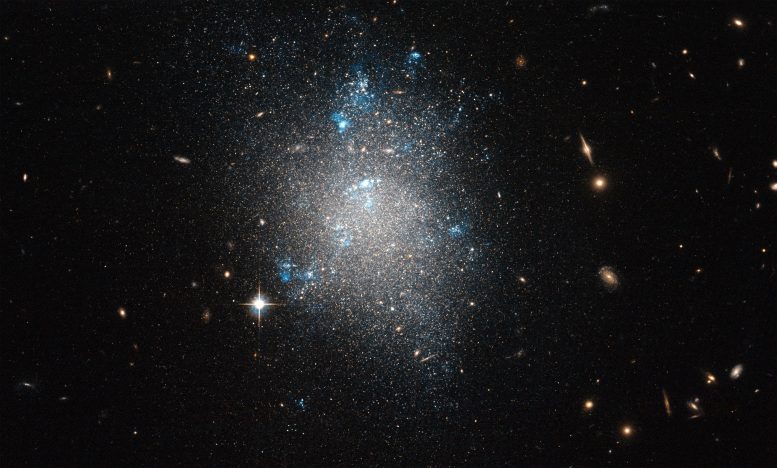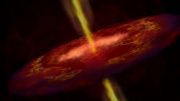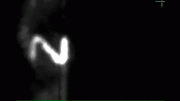
NGC 5477 a dwarf galaxy in the Messier 101 group, is the subject of this image from the NASA/ESA Hubble Space Telescope. Without obvious structure, but with visible signs of ongoing starbirth, NGC 5477 looks much like an archetypal dwarf irregular galaxy. The bright nebulae that extend across much of the galaxy are clouds of glowing hydrogen gas in which new stars are forming. These glow pinkish red in real life, although the selection of green and infrared filters through which this image was taken makes them appear almost white. Credit: ESA/Hubble & NASA
Using “characterization by proxy” and observations from the Kepler Space Telescope, researchers take a closer look at Kepler-61b, a planet orbiting near the inner edge of the habitable zone of the low-mass star Kepler-61.
A University of Washington (UW) astronomer is using Earth’s interstellar neighbors to learn the nature of certain stars too far away to be directly measured or observed, and the planets they may host.
“Characterization by proxy” is the technique used by Sarah Ballard, a post-doctoral researcher at the UW, to infer the properties of small, relatively cool stars too distant for measurement, by comparing them to closer stars that now can be directly observed.
Ballard is the lead author of a study accepted for publication in The Astrophysical Journal that used this method and observations from the Kepler Space Telescope to learn the nature of the distant star Kepler-61.
Our understanding of the size and temperature of planets depends crucially on the size and temperature of the stars they orbit. Astronomers already have a robust way to discern the physical properties of solar-type stars — those like the sun — by measuring the light they emit at different wavelengths and matching that to synthetically created spectra.
“The challenge is that small stars are incredibly difficult to characterize,” Ballard said. Those theoretical methods don’t work well for what are called M-dwarf stars, lower-mass stars about half the size of the sun and smaller — which is too bad, because such stars make up about three-quarters of the universe.
Ballard is using the characterization by proxy method to try to fill this knowledge gap. She is building on what she calls “truly remarkable” work by astronomer Tabetha Boyajian, now at Yale University, who uses a near-infrared interferometer — an array of telescopes working in unison studying light wavelengths a bit longer than visible light — to resolve the physical size of relatively nearby stars.
Ballard said her characterization by proxy method takes “full advantage that there now exists this precious sample” of relatively nearby stars that have been directly measured. You could say the method borrows a bit from Greek mathematician Euclid, whose first “common notion” held that things that equal the same thing must necessarily also equal each other.
In the new paper, Ballard and co-authors used this reasoning to learn about Kepler-61b, a planet orbiting near the inner edge of the habitable zone of the distant, low-mass star Kepler-61, about 900 light-years away in the Cygnus Constellation. A star’s habitable zone is that swath of space just right for an orbiting planet’s surface water to be in liquid form, thus giving life a chance.
She did this by comparing it to temperature size averages from four spectroscopically similar stars between 12 and 25 light-years away in the Ursa Major and Cygnus constellations. A light-year is about 6 trillion miles.
A funny thing also happened along the way: Kepler-61 turned out to be bigger and hotter than expected, which in turn recalibrated planet Kepler-61b’s relative size upward as well — meaning it, too, would be hotter than previously thought and no longer a resident of the star’s habitable zone.
All of this caused Ballard to informally subtitle the paper, “How Nearby Stars Bumped a Planet out of the Habitable Zone.”
Reference: “Exoplanet Characterization by Proxy: a Transiting 2.15 R⊕ Planet Near the Habitable Zone of the Late K dwarf Kepler-61″ by Sarah Ballard, David Charbonneau, Francois Fressin, Guillermo Torres, Jonathan Irwin, Jean-Michel Desert, Elisabeth Newton, Andrew W. Mann, David R. Ciardi, Justin R. Crepp, Christopher E. Henze, Stephen T. Bryson, Steven B. Howell, Elliott P. Horch, Mark E. Everett and Avi Shporer, 30 July 2013, The Astrophysical Journal.
DOI: 10.1088/0004-637X/773/2/98
Funding for the research came from NASA and its Jet Propulsion Laboratory at the California Institute of Technology.









Be the first to comment on "Astronomers Use “Characterization by Proxy” to Learn the Nature of Kepler-61"